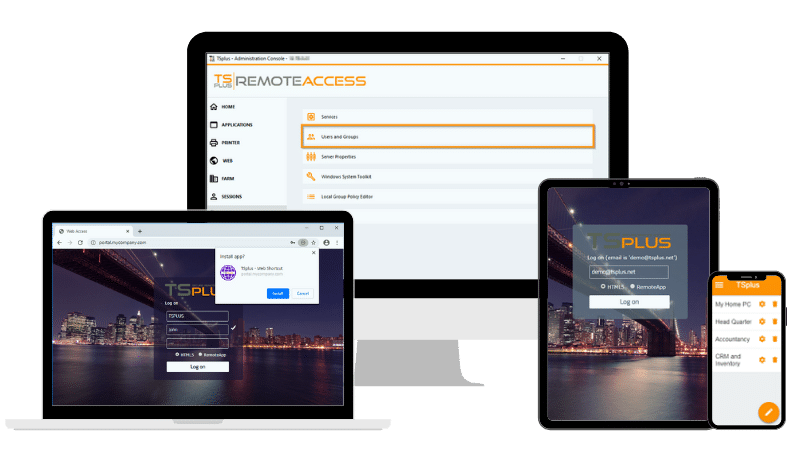)
)
Microsoft Windows Server Lifecycles
Windows Server 2019 follows Microsoft's Fixed Lifecycle Policy, which includes 5 years of mainstream support, concluding on January 9, 2024, followed by 5 years of extended support, ending on January 9, 2029. During mainstream support, users enjoy feature updates, bug fixes and security patches. Post-mainstream, during extended support, only security updates are provided. To navigate beyond these dates, organizations must either upgrade to newer server versions or opt for Extended Security Updates (ESU) to continue receiving critical security patches, thus maintaining compliance and security standards.

TSplus Remote Access Free Trial
Ultimate Citrix/RDS alternative for desktop/app access. Secure, cost-effective, on-premises/cloud
Windows Server 2019 Lifecycle
The lifecycle of Windows Server 2019 is governed by Microsoft's Fixed Lifecycle Policy, which provides a clear and predictable guideline for product support from its release through the end of support. Here are more detailed insights into these lifecycle phases specifically for Windows Server 2019:
1. Release Date: Windows Server 2019 was officially released on November 13, 2018.
2. Mainstream Support: This phase began on the release date and was set to end on January 9, 2024. During mainstream support, Microsoft provided all types of product support, including new features, bug fixes and security updates. This is the period during which the product benefited from full support and enhancements.
3. Extended Support: Following the end of mainstream support, extended support for Windows Server 2019 will last until January 9, 2029. In this phase, Microsoft continues to offer security updates and paid support but does not release new features, and non-security-related updates are generally not offered. The focus during extended support is primarily on maintaining the product’s security and stability rather than enhancing it.
4. Post-Extended Support: After the extended support phase ends, no further updates or fixes, including security updates, will be available. This is known as the end of life (EoL) of the product. Running software that has reached EoL may expose an organization to security risks and compliance issues since it will no longer receive security updates from Microsoft.
5. ESU: Extended Security Updates: For organizations using Windows Server 2019, planning for the future is crucial. As the end of mainstream and extended support phases approach, businesses should consider their upgrade paths or look into options such as the Extended Security Updates (ESU) program, which Microsoft offers for purchase. Beyond the end of the extended support phase, ESUs provide critical and important security updates for a fee.
Microsoft's official documentation and lifecycle fact sheet provide specific and detailed information on their lifecycle policy and can be an invaluable resource for IT professionals planning their infrastructure needs. For more details, you can visit the Microsoft Lifecycle Product Search page.
Extended Security Updates (ESU): Availability, Cost and Obtaining Process
What are Extended Security Updates (ESU)
As organizations continue to rely on legacy systems like Windows Server 2019 beyond their standard support lifecycle, Microsoft's Extended Security Updates (ESU) program becomes a crucial resource. ESU is designed to provide further security updates and critical patches for products that have reached their end of life (EoL). This ensures that businesses can maintain compliance and protect their IT environments against vulnerabilities while they transition to newer technologies.
Availability of ESUs for Windows Server
ESUs are available for various Microsoft products, including Windows Server versions, typically for a period of up to three years after the end of the extended support phase. For Windows Server 2019, ESUs will likely be available starting from January 2029, immediately following the end of its extended support. The availability of ESUs can vary based on the specific edition of the server (e.g., Datacenter, Standard…) and the volume licensing or software assurance agreements in place.
Cost of ESUs
The cost of ESUs depends on the specific product and the volume of licenses required. Pricing is generally structured as an annual subscription, with the cost potentially increasing each year. This tiered pricing reflects the increasing cost of maintaining older software. Businesses can purchase ESUs through their usual Microsoft licensing channels. For companies covered under volume licensing agreements, there may be specific terms and conditions that adjust the pricing. For smaller businesses, ESUs might represent a significant expense, so it is essential to factor these costs into an SME’s IT budget planning.
Process for Obtaining ESUs
Obtaining ESUs involves several steps:
- Assessment: Businesses should first assess their need for ESUs by inventorying their environments to determine which systems are running Windows Server 2019 and would require extended updates.
- Eligibility: Check eligibility for the program through Microsoft Volume Licensing Service Center or your Microsoft account manager. Not all systems may qualify for ESUs, and eligibility might depend on the existing licensing agreements.
- Purchase: Once eligibility is confirmed, organizations can purchase ESU licenses. This process typically involves contacting a Microsoft sales representative or a licensed Microsoft partner.
- Activation: After purchase, businesses will receive a key to activate the ESU on eligible systems. This key ensures that the servers continue to receive security updates from Microsoft.
- Implementation: Finally, IT administrators need to apply the updates manually or configure systems for automatic updates to ensure that the servers are protected against any new vulnerabilities.
Continued Compliance and Security
By purchasing ESUs, businesses ensure that their systems remain compliant with industry regulations that may require supported software for data protection. Furthermore, ESUs provide peace of mind by securing critical infrastructure against exploitation of vulnerabilities that could be costly both financially and reputationally.
The ESU program is therefore a valuable resource for businesses that need more time to migrate off older platforms. By understanding the availability, cost and process of obtaining ESUs, organizations can make informed decisions that align with their long-term IT strategy and budget constraints. This proactive approach not only secures their legacy systems but also provides a clearer pathway for eventual migration to newer, supported versions of Windows Server or alternative solutions.
TSplus Remote Access Implementation
With the upcoming end of life for Windows Server 2019, implementing Remote Access technologies is more than just a stop-gap measure: it is a strategic move that ensures continuous, secure and efficient operation. Remote Access tools like those provided by TSplus allow system administrators to manage server operations remotely, offering a robust alternative to traditional on-premises management. This shift not only enhances operational flexibility but also reduces the need for physical presence, which can be crucial when implementing an ESU program on EOL software as well as during unforeseen events like health crises or natural disasters.
Features of Remote Access and Their Benefits
Here are some of the benefits of TSplus Remote Access technologies:
- HTML5 Clients: These clients enable access from any modern web browser, eliminating the need for traditional software installations and allowing users to operate within a familiar interface with minimal learning curve.
- Universal Printer: This feature facilitates printing tasks from any location without installing specific drivers on remote devices. It simplifies the printing process, especially in environments where users need to print from various remote locations.
- Enhanced Security: Remote Access solutions incorporate robust security measures such as two-factor authentication, secure tunneling and end-to-end encryption, safeguarding data integrity and preventing untimely access by specified users or groups.
- Customization and Control: These systems provide extensive customization options, allowing IT administrators to configure settings to match specific organizational requirements. This granular level of control is essential for maintaining system security and operational efficiency.
Practical Implications for Users
As Windows Server 2019 moves closer to its end of life, the practical implications for users are significant. Without proper planning for upgrades or transitions, organizations risk running unsupported software, which could lead to security vulnerabilities and compliance issues. TSplus Remote Access solutions offer a way to maintain legacy applications and ensure that users can continue to access critical systems without interruption. Moreover, these technologies support the growing trend towards remote work, providing reliable and secure access to organizational resources from anywhere in the world.
Concluding on Windows Server 2019 EoL
As we consider the End of Life for Windows Server 2019, it is clear that challenges lie ahead, but so do opportunities. By proactively integrating Remote Access technologies, organizations can not only extend the life of their existing server infrastructure but also enhance their operational capabilities. Solutions such as those from TSplus offer secure, scalable and cost-effective alternatives ensuring businesses can continue to operate efficiently wherever they are around the globe.
Additionally, by staying well-informed about the lifecycle of essential technologies and adopting innovative solutions like Remote Access, businesses can protect their investments and infrastructure, thus remaining competitive in this fast-paced world. Properly planning for the EoL will enable organizations to transition smoothly and maintain continuous operations, securing their IT infrastructure against future uncertainties. This proactive approach is key to ensuring a secure, efficient and forward-thinking IT environment.














)
)
)